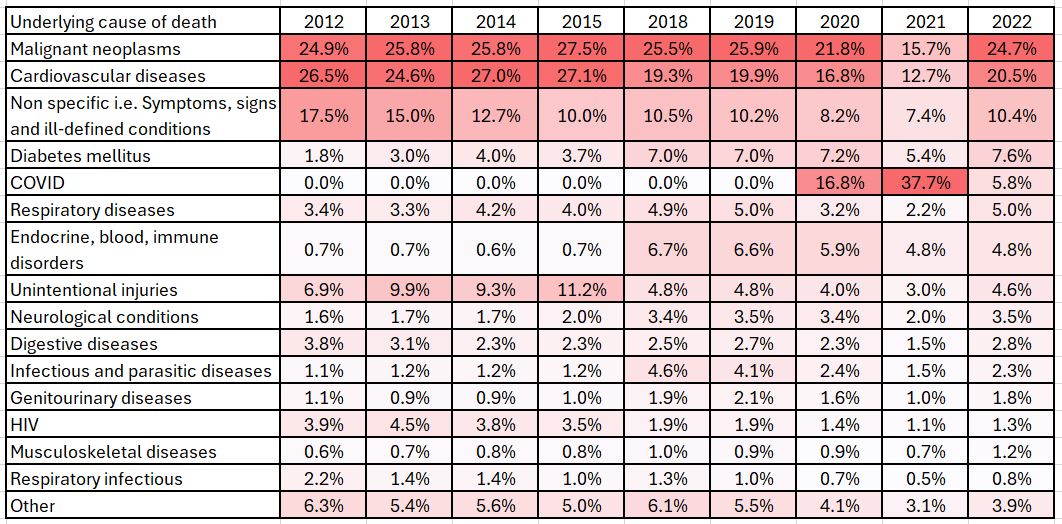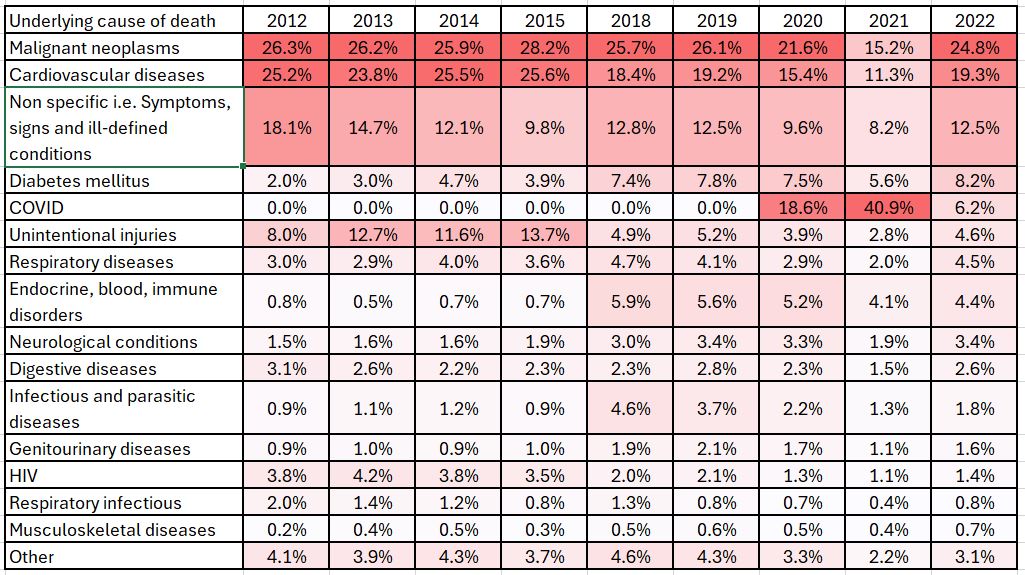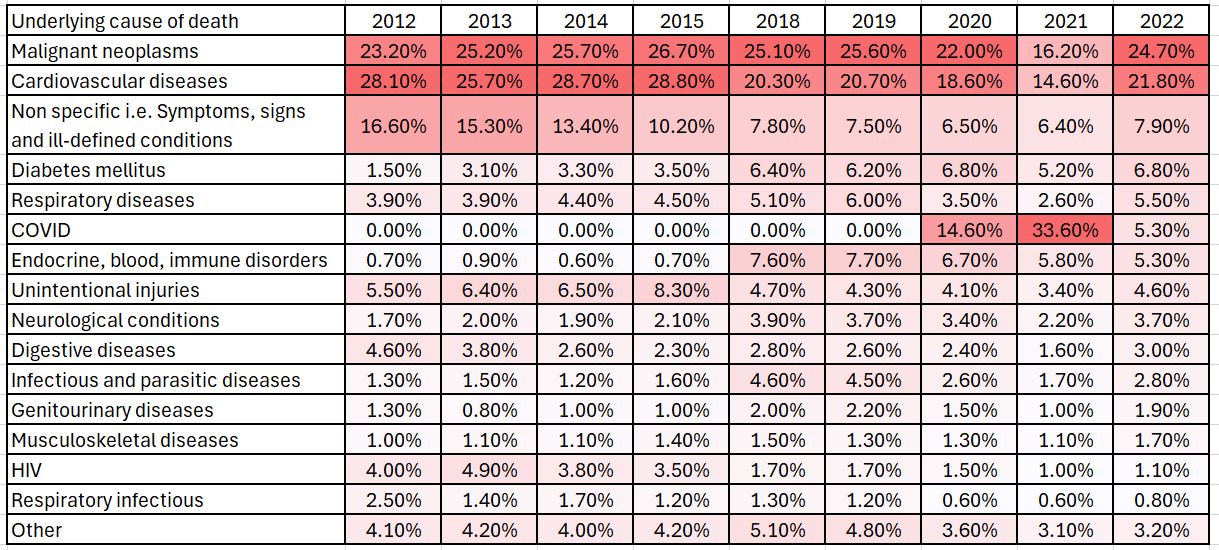COVID-19 led to the highest death rates ever recorded among Discovery Health Medical Scheme members, finds 13-year review of mortality rates

Although mortality rates reached a historic high during the pandemic's second year, death rates have returned to near pre-pandemic levels. Still, males remained at an increased risk of death even in 2022 compared to pre-pandemic death rates, our analysis shows.
Authors
Lizelle Steenkamp (Senior Healthcare Statistician), Lebohang Radebe (Data Scientist, Discovery Health), Shirley Collie (Chief Health Analytics Actuary)
We set out to investigate:
Mortality or death trends over time across members of the Discovery Health Medical Scheme (DHMS), one of the many medical aid schemes administered by Discovery Health. DHMS is South Africa's largest open enrolment medical scheme. In particular, we were interested in the impact of COVID-19, and the main drivers of mortality.
How do we calculate mortality?
Mortality is strongly correlated with an individual's age, sex and underlying health conditions. Shifts in DHMS member demographics over time can therefore result in changes in the mortality rates.
To account for changing demographics, we calculated death rates in two ways:
- Without taking into account demographic shifts, the crude mortality rate is calculated as the number of all deaths in a given period divided by the population exposed to risk of death in that period. This allows us to understand the total number of members dying per 100,000 life years.
- Taking into account demographic shifts, the age- and sex-standardised mortality rate is calculated as a weighted average of the age and sex specific mortality rates per 100,000 lives, where the weights are the proportions of lives in the corresponding age and sex groups in the 2019 DHMS population. This allows us to understand if the rates of death per 100,000 life years are increasing within a given age and sex group.
Mortality trends over the last 13 years
Between 2010 and 2019, the overall crude mortality rate for DHMS members increased by 20%. Still, the average age of scheme members during this period also increased by 2.62 years. When accounting - or adjusting - for this older population and changes in sex during this time, the age- and sex-standardised death rate actually fell by 10% (from 515 deaths to 461 deaths per 100,000 life years).
Both crude and standardised death rates, however, reached historic levels during the first two years of the COVID-19 pandemic in South Africa. In 2020, overall death rates for DHMS members increased to 542 deaths per 100,000 lives, already higher than pre-pandemic levels. Mortality rates went on to reach their highest level in the history of the scheme in 2021 at 767 deaths per 100,000 life years.
Death rates however had returned to near pre-pandemic levels in 2022 at 477 deaths per 100,000 life years.

Figure 1: All-cause crude and age- and sex-standardised mortality rates for DHMS from 2010 to 2022
Before and after COVID-19: How do death rates vary by sex?
Death rates among scheme members have historically been higher for males than for females, but this gap was narrowing prior to the COVID-19 pandemic. This analysis did not evaluate why this discrepancy exists. Still, this pattern is seen globally, and its causes are thought to be complex, ranging from genetics and socialisation to differences in health-seeking behaviour.1
Before to the pandemic, the difference between DHMS members' male and female age-standardised death rates was largest in 2010, when 151 more males per 100,000 life years died than females. By 2019, this divide had diminished and the rate difference between males and females was 99 deaths per 100,000 life years. Overall, between 2010 and 2019, males saw a 14% reduction in overall age-standardised mortality rates whilst females only saw a 6% reduction in age-adjusted death rates.
But males saw a much higher increase in mortality rates during the early years of the pandemic and remained at an increased higher risk of death than females even in 2022 compared to pre-pandemic levels: In 2022 male mortality risk was 4.4% higher, and female mortality risk was 2.0% higher than pre-pandemic levels.

Figure 2: All-cause, age- and sex-standardised mortality rates split by sex for DHMS from 2010 to 2022
Were increased deaths during the pandemic really due to COVID-19?
When we removed deaths coded by healthcare workers as having been related to COVID-19 from the analysis, we note only a slightly elevated mortality risk in 2021. This means COVID-19 related deaths are responsible for the majority of the excess deaths seen in the 2020 and 2021 periods.

Figure 3: All-cause, age-and sex-standardised mortality rates - after excluding COVID-19 deaths for DHMS - split by sex from 2010 to 2022
We also note, after excluding COVID19 related deaths, that the mortality rates for both males and females are lower than pre-pandemic levels in 2019.
What were DHMS members' leading causes of death in the last 10 years?
Next, our analysis evaluated cause of death data from 2012 to 2022. Over the last decade, the 10 leading causes of death have generally remained the same, albeit with different rankings. The leading cause of death in 2012 was cardiovascular diseases (26.5%). Cancer (24.9%) was the second leading cause of death in 2012, followed by non specific deaths i.e. coded as symptoms, signs and ill-defined conditions (17.5%). The same three conditions ranked as the top three drivers of deaths in 2022 however cancer overtook cardiovascular related deaths. Diabetes, increased from a ranking of nineth in 2012 to fourth in 2022. Lastly, COVID-19 was the leading cause of death in 2021.
Table 1: Proportion of deaths by underlying cause of death from 2012 to 2022

*2016 and 2017 underlying cause of death coding is not available on the DHMS population
Females may be less likely to die than males, but their causes of death were largely similar
Cancer has been the leading cause of death for both males and females since 2012. In 2012, cancer accounted for 26.3% of 2012 deaths in males, falling slightly in 2022 to account for 24.8% of mortality among males. The proportion of cancer deaths among females was similar, comprising 23.2% of deaths in 2012. The proportion of female deaths from cancer (24.7%) remained largely unchanged in 2022.
Table 2: Proportion of deaths by underlying cause of death from 2012 to 2022 for males

Across both males and females, there has been a drop in the proportion of cardiac-related deaths between 2012 and 2022: a 23.4% reduction was experienced for males and a 22.5% reduction was experienced for females. Males also suffered a higher burden of these deaths initially.
Diabetes, however, gained ground as a leading cause of death over the same period to become the fourth leading cause of death for males and females. A decade ago, the condition ranked as the eighth leading cause of death for men and, similarly, the tenth leading cause of mortality among females.
COVID-19 was the leading cause of death for both males and females in 2021.
Table 3: Proportion of deaths by underlying cause of death from 2012 to 2022 for females

Conclusion
Males saw a much higher increase in mortality rates during the early years of the pandemic and remained at an increased risk of death even in 2022 compared to pre-pandemic levels. When excluding COVID-19 related deaths, both females and males in 2022 experienced mortality rates lower than pre-pandemic levels.
Overall, underlying causes of deaths have remained consistent for males and females over the past 13 years. Although deaths attributed to heart disease have fallen during this period, the proportion of deaths due to diabetes increased. Cancer has been and remained the single leading cause of death for DHMS clients between 2012 and 2022, except for 2021 when COVID-19 became the leading cause of death.
- Shmerling RH. Why men often die earlier than women. Harvard Health. Published February 19, 2016. Accessed February 19, 2023. https://www.health.harvard.edu/blog/why-men-often-die-earlier-than-women-201602199137
Interested in knowing more or reporting on these findings?
Please contact us on MEDIA_RELATIONS_TEAM@discovery.co.za to request any updated data available since publication and to obtain any further context required.
Did you find this post interesting?
Read our related post on how Discovery Health is developing new ways of measuring the quality of hospital care
Disclaimer
ALL INFORMATION SHARED ON THIS PAGE IS BASED ON PERSPECTIVES GAINED FROM ANALYSIS OF FIGURES AND TRENDS EMANATING FROM DISCOVERY HEALTH'S DATA POOL. THE ANALYSIS, WHICH IS CONDUCTED BY DISCOVERY HEALTH'S ACTUARIAL AND DATA SCIENTIST TEAM, AIMS TO ENCOURAGE INDUSTRY DIALOGUE. THIS CONTENT IS SHARED FOR EDUCATIONAL AND INFORMATIONAL PURPOSES ONLY. IT DOES NOT CONSTITUTE PEER-REVIEWED, PUBLISHED SCIENTIFIC RESEARCH, AND HENCE SHOULD NOT BE INTERPRETED AS SUCH OR USED AS A BASIS FOR ALTERING TREATMENT DECISIONS.

Deep dive: Admission rates across South Africa's four COVID-19 waves confirm Omicron-driven fourth wave's lower severity, and more.
07 July 2022
Authors: Chana Suttner (Actuary, Discovery Health),Michael Cohen (Actuarial Analyst, Discovery Health), Shirley Collie (Chief Healthcare Analytics Actuary, Discovery Health

Long COVID symptoms, impact on carrying out daily activities: Survey of just over 7,000 medical scheme members reveals key insights
16 June 2022
Authors: Shirley Collie (Chief Healthcare Analytics Actuary, Discovery Health), Lizelle Steenkamp (Senior Healthcare Statistician, Discovery Health), Lebohang Radebe (Data Scientist, Discovery Health), Dr Smybinn Mathews (Clinician, Discovery Health) and Dr Dave Jacobs (Senior Clinician and Clinical Classification System Architect, Discovery Health)

Discovery's COVID-19 personal resilience index predicts an individual's resilience to serious COVID-19 illness
23 May 2022
Authors: Lizelle Steenkamp (Senior Healthcare Statistician at Discovery Health), Tommy Chen (Actuary at Discovery Health), Jared Champion (Senior Actuary at Discovery Health) and Donald Ntjana (Senior Data Scientist at Discovery Health)